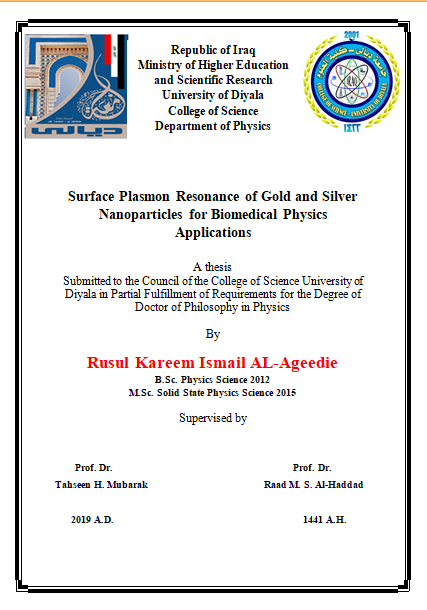Abstract
In this study, an identical surface plasmon resonance (SPR) within high surface energy of gold and silver nanoparticles spherical was chemically synthesized without and with coating by nano thin film layer of silica for treating the cell lines (MCF-7 and HBL-100).
Gold nanoparticles were chemically synthesized by Turkevich method from chloroauric acid and trisodium citrate dihydrate. The determination of the parameters effect such as temperature, trisodium citrate dihydrate content, deionized water volume, mixing speed, SiO2 content, deionized water volume, gold nanoparticles solution volume and ethanol volume on the position of surface plasmon resonance (SPR), particle size, size distribution and shape gold nanoparticles in the blue and red shift regions were confirmed. While silver nanoparticles were chemically synthesized by reduction with gallic acid from silver nitrate and gallic acid, also the parameters effect such as time, gallic acid weight, temperature, SiO2 content, silver nanoparticles solution volume and ethanol volume on position of surface plasmon resonance (SPR) of silver nanoparticles in blue and red shift regions were confirmed.
Optical measurements results showed peak band surface plasmon resonance (SPR) of gold nanoparticles (AuNPs) at 515nm and this peak shifted to 518nm after coating. In same time, the optical measurements of silver nanoparticles (AgNPs) adjusted by NaOH and NH4OH showed that the peak band surface plasmon resonance (SPR) was shifted from 396nm to 398nm and from 405nm to 414nm respectively.
FTIR spectrum measurements results showed strong absorption peaks of the gold nanoparticles at 3431, 2341, 1627, 1506, 1388, 975, 962,632, 524 and 499 cm-1, also strong absorption peaks showed at 3431, 2866, 2802, 2343, 2320 ,1622, 1616, 1494 1489 ,1384, 1379, 1072, 1062, 966, 655,636 543, 484 and 426 cm-1 of silver nanoparticles adjusted by NaOH and NH4OH, also it is observed that the gold and silver nanoparticles after coating almost have the same absorption peaks with a little shift for some absorption peaks this means that the coating method led to a little increase in the size with maintaining on nanoparticles shape and prevents it from deforming, the absorption bands 524 and 499 cm-1 of gold nanoparticles refer to harmony happening between inorganic elements (gold) and organic compounds (Trisodium Citrate Dihydrate), while refer the absorption bands 543, 484 and 426 cm-1 of silver nanoparticles to harmony happening between inorganic elements (silver) and organic compounds (Gallic acid).
Structure measurements results showed that the gold nanoparticles have a narrow size distribution and spherical shape with an average size 3-6nm. On another hand, there was a narrow size distribution and a little increase in the particles size 9-18nm that retaining its spherical shape with stability increase from (−25.02mV) to (−25.92mV) after coating by nano thin film layer of silica. In same time, the structure measurements of silver nanoparticles (AgNPs) adjusted by NaOH and NH4OH showed have a narrow size distribution and spherical shape with an average 6-8nm and 3-6nm respectively. On another hand, there was a narrow size distribution and a little increase in the particles size10-19nm and 12.9-16.7nm of coated AgNPs adjusted by NaOH and NH4OH respectively that retaining its spherical shape with stability increase from (−58.17mV) and (−15.68mV) to (−62.86mV) and (−43.60mV) respectively after coating by nano thin film layer of silica.
Toxicity examination results showed of the surface plasmon resonance (SPR) of gold and silver nanoparticles without and with coating by nano thin film layer of silica have ability to destroy for MCF-7 cells at all concentrations. While, surface plasmon resonance (SPR) of gold and silver nanoparticles showed different effects on the normal HBL -100 cell line.
Therefore, the best optimization concentration of surface plasmon resonance (SPR) of gold nanoparticles (AuNPs) before and after coating by nano thin film layer of silica on MCF-7 and HBL-100 cell lines was 50μg/ml and 25μg/ml respectively showed the best rate of destroy MCF-7 cell line and on same time 50μg/ml and 25μg/ml was less the destroy rate of HBL-100 cell. While, the best optimization concentration of surface plasmon resonance (SPR) of silver nanoparticles (AgNPs) adjusted by NaOH and NH4OH before and after coating by nano thin film layer of silica on MCF-7 and HBL-100 cell lines was 50μg/ml showed the best rate of destroy MCF-7 cell line and on same time 50μg/ml was increased the growth rate of HBL-100 cell.
Therefore, this study also provides the conclusive evidence of surface plasmon resonance (SPR) of gold and silver nanoparticles has toxic effect against breast cancer MCF-7 cell line at all concentrations compared with HBL-100 normal breast cell line. Further studies are required to elucidate the precise molecular mechanism involved in cell growth inhibition thereby permitting the synthesized chemically surface plasmon resonance (SPR) of gold and silver nanoparticles of cancer chemopreventive and/or therapeutic agents.




